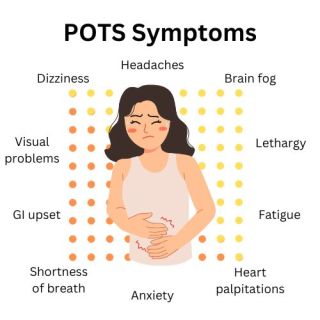Postural Orthostatic Tachycardia Syndrome (POTS) is a condition that affects the autonomic nervous system, and recognizing pots symptoms early on can make a significant difference. These symptoms commonly include rapid heartbeat (tachycardia) upon standing, lightheadedness, brain fog, fatigue, heart palpitations, blurred vision, and shortness of breath. Individuals may also experience chronic headaches, tremulousness, nausea, and leg weakness or heaviness when upright.
Understanding POTS Disease
POTS disease is characterized by an excessive heart rate increase of over 30 beats per minute (or over 40 bpm in adolescents) within 10 minutes of standing, without a significant drop in blood pressure. This abnormal response can lead to various debilitating symptoms that impact daily life.
Key Symptoms to Watch For

POTS manifests through a spectrum of symptoms, which can vary in intensity and frequency:
1- Dizziness and Lightheadedness
A prevalent symptom, occurring in approximately 95% of POTS patients, especially upon standing.
2- Rapid Heart Rate (Tachycardia)
An increase in heart rate by more than 30 bpm upon standing is a hallmark of POTS.
3- Fatigue
Chronic exhaustion that doesn’t improve with rest, affects daily activities.
4- Brain Fog
Cognitive difficulties, including trouble concentrating and memory lapses.
5- Palpitations
A sensation of a racing or pounding heart, often accompanied by anxiety.
6- Nausea and Gastrointestinal Issues
Symptoms such as nausea, bloating, and abdominal discomfort.
7- Fainting or Near-Fainting Episodes
Syncope or presyncope, particularly after prolonged standing or exertion.
8- Shortness of Breath
Difficulty breathing, especially when upright.
9- Chest Pain
Discomfort or pain in the chest area is not necessarily related to heart disease.
10- Shaking and Sweating
Involuntary tremors and excessive sweating, are often triggered by standing.
When to Seek Medical Attention
If you experience a combination of these symptoms, especially if they worsen upon standing and improve when lying down, it’s essential to consult a healthcare professional. Early diagnosis and intervention can significantly improve quality of life.
Finding the Right Specialist
Given the complexity of POTS, consulting a cardiologist familiar with autonomic disorders is advisable. For women, seeking a female cardiologist near me can provide a more comfortable environment to discuss sensitive health issues. Some Specialized clinics, offer tailored care for women’s cardiovascular needs.
Management and Treatment Strategies
While there’s no cure for POTS, various approaches can help manage symptoms:
1- Lifestyle Modifications: Increasing fluid and salt intake, wearing compression garments, and engaging in regular, gentle exercise.
2- Medications: Beta-blockers, fludrocortisone, and midodrine may be prescribed to regulate heart rate and blood pressure.
3- Physical Therapy: Tailored programs to improve circulation and autonomic function.
4- Psychological Support: Counseling or therapy to address the emotional impact of chronic illness.
Conclusion
POTS is a multifaceted condition that requires a comprehensive approach to diagnosis and management. By recognizing the signs and seeking specialised care, individuals can take proactive steps toward improving their health and well-being. Remember, if you’re experiencing symptoms consistent with POTS, don’t hesitate to consult a healthcare provider, such as a female cardiologist near me, to explore your options.





